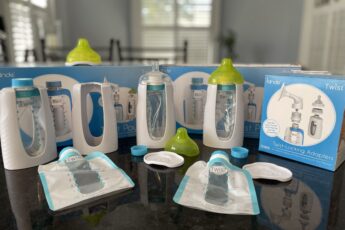
What It Is:
A wireless, wearable electric breast pump designed to allow you to pump discreetly. The Willow allows you to pump breast milk into bags or containers with motors that can be completely covered and housed in your bra. It works in tandem with a phone application that is available for iPhones (14.x or later) and Androids (10.x or later).
Available Here (24mm) and Here (27mm)
Price: $499 (plus 17.99 if you select a flange size other than 24mm)
What It Includes:
2 Willow Pumps
2 Flanges
2 Flextubes™ (part of the Willow’s “pump parts”)
24 Four-ounce Milk Bags (Recyclable and not made with BPA)
2 Cleaning Brushes
1 Charger
1 Year Warranty (see the Willow website for more detail)
Flange Sizes Available (some only available on Willow’s website):
15mm, 17mm, 19mm
21mm, 24mm, 27mm
When I purchased my Willow, only three flange sizes were available—the 21mm, 24mm, and 27mm—by selecting the 21mm flange, I received the Willow pump kit which included two 24mm flanges and two 21mm flanges. This meant I could try the 21mm but that if I ended up needing to use inserts, I had the 24mm flanges to put inserts into. Willow offers inserts in sizes 15mm, 17mm, and 19mm. Using the right sized flange will prevent discomfort and promote efficient milk removal. For more information on flange sizing, click here.
Other Expenses:
If you continue to use the bags that come with the Willow 3.0, you will need to replace them fairly often. One pack of bag contains 48 bags and costs $23.99 (25.99 on Amazon). There is no discount for buying the bags in bulk. If you use the Willow exclusively, one pack will likely only last you a few days—48 bags breaks down into 24 bags (one for each side) and if you pump 6 times a day, that one pack will only last 4 days. Moreover, each bag only holds 4 ounces, so if you produce more milk than that during a pump session, you will need to replace the bag during your pump session.
If you decide you do not want to use the Willow bags, you have the option to purchase a set of 2 containers for $49.99. The containers also hold 4 ounces of milk but are a more budget-friendly option. However, just like any pump part, the containers need to be replaced every so often. Note that while the containers still provide you freedom of movement, unlike the bags they are not completely leak-proof. According to the Willow website, you can walk around, lean over a crib, and pick up toys with the containers, but the containers are not recommended for use during yoga, running, cycling, or lying down—all of which are things you can do with the bags. I’ve been told that the containers are also a little tricky to clean.
Just like other pumps, you will also need to replace pump parts from time to time. For the Willow, it is recommended you replace the flextubes, flanges/containers, and the inserts (if you use them) every three months.
Lastly, you may want to buy a second charger—$29.99—to allow you to charge both the right and left Willow pumps at the same time. You are estimated to get five pumping sessions out of 1 full charge, but whether that is true for you depends on how long you pump at each session. The time to fully charge is 2 hours.
Insurance:
Some insurance companies cover all or part of the cost of the Willow, so it’s worth checking into! Even if your insurance company doesn’t, you may still be able to purchase it using your FSA or HSA.
Noise Level:
The noise the Willow makes is noticeable, but I thought it was more discreet than the Spectra, Medela Symphony, or Ameda Mya.
Visibility:
You are meant to pump with the Willow in your bra, which helps support the weight of the pumps. This means you can pump as covered as you like! I will note that I felt like it was very obvious that I was using the Willow—it pushed my chest out so far and gave me a robotic look. Fortunately, I was able to make the robo-boobs less noticeable by wearing a baggy sweater.
Suction/Efficiency at Milk Removal:
The suction felt strong to me, but it was a different sensation than the tug and release of most other pumps. Some mamas who are used to pumping on another pump system may struggle to pump using the Willow because their bodies are not used to releasing milk to the sensation of the Willow. If you are having trouble letting-down while using the Willow, check out my post on switching pumps. However, one friend commented that the Willow felt more like her baby’s suck than any other pump she had tried.
Comfort Level/Ease of Use:
If you are using the right-sized flange and positioning the Willow pumps as directed—which takes practice!—I found that pumping with the Willow could be just as comfortable as pumping on any other pump. It is so important to fully read the instruction manual to make sure you are using the pump correctly.
Parts to Clean:
Two parts per side if you use the bags (the flange and flex tube). Four parts per side if you use the reusable containers. Add an additional piece to each side if you are using inserts.
The EP&Me Take:
Pros: The most obvious benefit of using the Willow is the freedom it gives you. You are hands-free and can accomplish most, if not all of the tasks you would be able to do when not pumping. Additionally, if you decide to use the bags, they really are leak-proof, your milk is already in a “container” for storage in the fridge, and you have only 4 parts total to wash. Win, win, win! Additionally, one mama friend let me know how impressed she has been with Willow’s customer service: she thought Willow was fast, helpful, and had provided her with a great solution—replacement of the one pump with an orange light that was not be solved by Willow’s basic troubleshooting.
Cons: The cost of the Willow is steep (and even more so when you factor in using the bags!) and even if you decide to purchase the Willow, there is no guarantee that you will get it to work for you (though I am told that Willow’s customer service is great for helping you troubleshoot any issues). It’s also a bummer that the device comes with only get one charger. I also noticed that I would lose a little bit of milk in the flex tube and the bags; not a significant amount, but when every drop of breast milk feels precious, it’s hard not to notice these things. The Willow app allows you to see how much milk you’ve pumped in real time; however, it often wasn’t accurate for me, and I’ve seen and heard the same complaint made by other mamas. You can remedy this issue by measuring the bags of milk or containers using kitchen scale if necessary, but it is one more step to do, which may not be desirable. Finally, you are not able to use techniques like massage and compression to help empty your breasts because of the way the Willow is fitted to your breast.
Verdict: Given the Willow’s price point, I think it’s a risky purchase, and I wouldn’t recommend EPers rely on the Willow as their only pump until they know the Willow works well for them. I was glad I had a back-up pump, because I couldn’t commit the time necessary to train my body on the Willow and ended up returning to pumping with my Spectra full-time. However, if you can afford the pump, and being hands-free or movement while pumping is a priority for you, this pump is an excellent option and worth a try especially if you are at a point where you may otherwise need to stop pumping. I personally hope to find success with the Willow during my next pumping journey!







